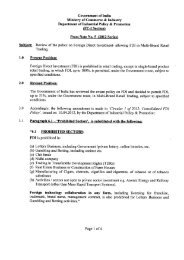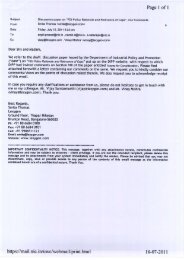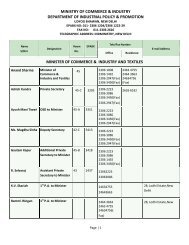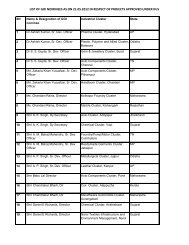fdi in india and its growth linkages - Department Of Industrial Policy ...
fdi in india and its growth linkages - Department Of Industrial Policy ...
fdi in india and its growth linkages - Department Of Industrial Policy ...
You also want an ePaper? Increase the reach of your titles
YUMPU automatically turns print PDFs into web optimized ePapers that Google loves.
Chapter 9: Maps of Spatial Spread<br />
of FDI-Enabled Firms<br />
9.1 Introduction<br />
The spatial spread of FDI-enabled firms (both services <strong>and</strong> manufactur<strong>in</strong>g) is one of the major objectives of the study.<br />
With the help of the Capital<strong>in</strong>e database, as described <strong>in</strong> Chapter 6 of the study, an attempt has been made to further<br />
depict the spatial spread of FDI firms, both services <strong>and</strong> manufactur<strong>in</strong>g, us<strong>in</strong>g thematic maps.<br />
Capital<strong>in</strong>e data provided us with 503 FDI companies, of which 403 were manufactur<strong>in</strong>g <strong>and</strong> 100 were service<br />
companies. The 403 manufactur<strong>in</strong>g companies comprised 1240 plants, which are spread across 306 towns <strong>in</strong> various<br />
states of India. Similarly, 100 service companies operate through 1,257 facilities that are distributed across 381 towns <strong>in</strong><br />
various states. In total, the plants <strong>and</strong> facilities of FDI companies are located <strong>in</strong> 687 towns.<br />
Us<strong>in</strong>g the addresses of the plants <strong>and</strong> service firms, the 1,240 plants <strong>and</strong> 1,257 facilities were arranged district-wise with<br />
p<strong>in</strong> codes <strong>and</strong> plotted on a map of India with state boundaries to see the spatial spread of FDI-enabled firms across the<br />
states. The Equal Ranges method was used to group the plants/facilities <strong>in</strong>to district clusters before plott<strong>in</strong>g them on<br />
the map.<br />
The Equal Ranges method is a common classification technique that provides the values of ranges to plot maps. 1 The<br />
range values obta<strong>in</strong>ed from the Equal Ranges Method best represent the data values of the map.<br />
Us<strong>in</strong>g the Equal Ranges Method, we plotted 10 maps (five for manufactur<strong>in</strong>g firms <strong>and</strong> five for service facilities) by<br />
super-impos<strong>in</strong>g the cluster of FDI plants/facilities on a different base each time. The maps are described below <strong>and</strong><br />
appended to this section.<br />
Box 1: Equal Range Method<br />
This method establishes the m<strong>in</strong>imum <strong>and</strong> maximum values of the data items. The difference<br />
between the m<strong>in</strong>imum <strong>and</strong> maximum is calculated <strong>and</strong> then divided by the number of ranges (i.e.,<br />
5) to establish the equal range value. For example, the m<strong>in</strong>imum number of persons born overseas<br />
is 578 <strong>and</strong> the maximum number of persons born overseas is 14,547. The difference is 13,969, which<br />
is divided by the number of ranges (i.e., 5), which equals 2793. The ranges are divided <strong>in</strong>to segments<br />
of 2,800, i.e., 500 to 3,300, 3300 to 6,100, etc.<br />
Source: Australian Bureau of Statistics, H<strong>in</strong>ts <strong>and</strong> Tips - Range Methods of Thematic Maps.<br />
9.2 Spread of FDI-enabled Manufactur<strong>in</strong>g Plants<br />
Map 1: Spatial spread of FDI-enabled plants <strong>in</strong> India<br />
The spatial spread of FDI-enabled plants shows that there are 1,240 plants spread across 306 cities across India. <strong>Of</strong><br />
these 1,240 plants, 721 plants are located <strong>in</strong> 264 Class-3 cities, 85 plants <strong>in</strong> 21 Class-2 cities <strong>and</strong> 434 plants <strong>in</strong> 21<br />
Class-1 cities.<br />
1. Other classification techniques <strong>in</strong>clude the Equal Count Method, Natural Break Method, St<strong>and</strong>ard Deviation Method, <strong>and</strong> Quantile Method.<br />
117












